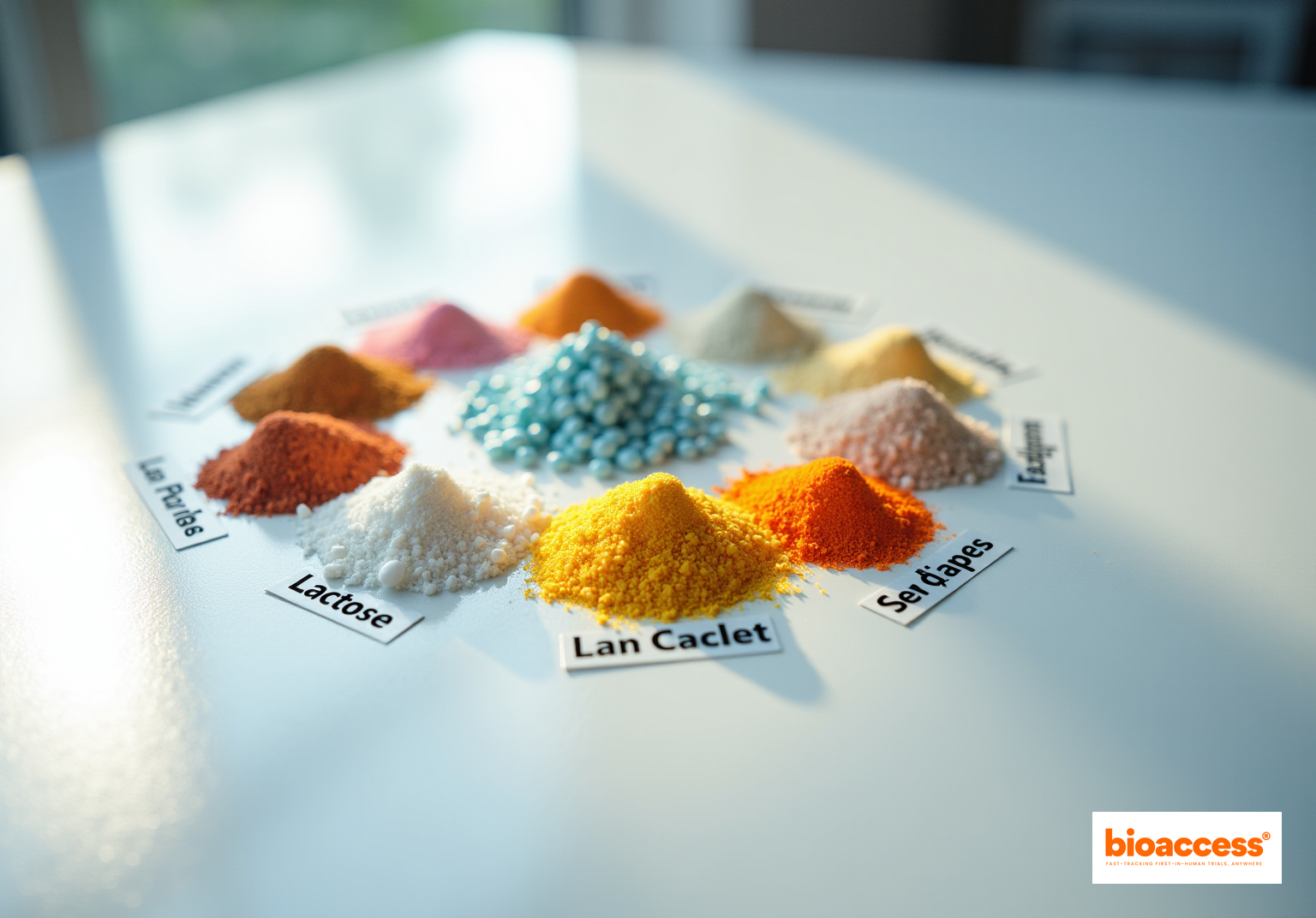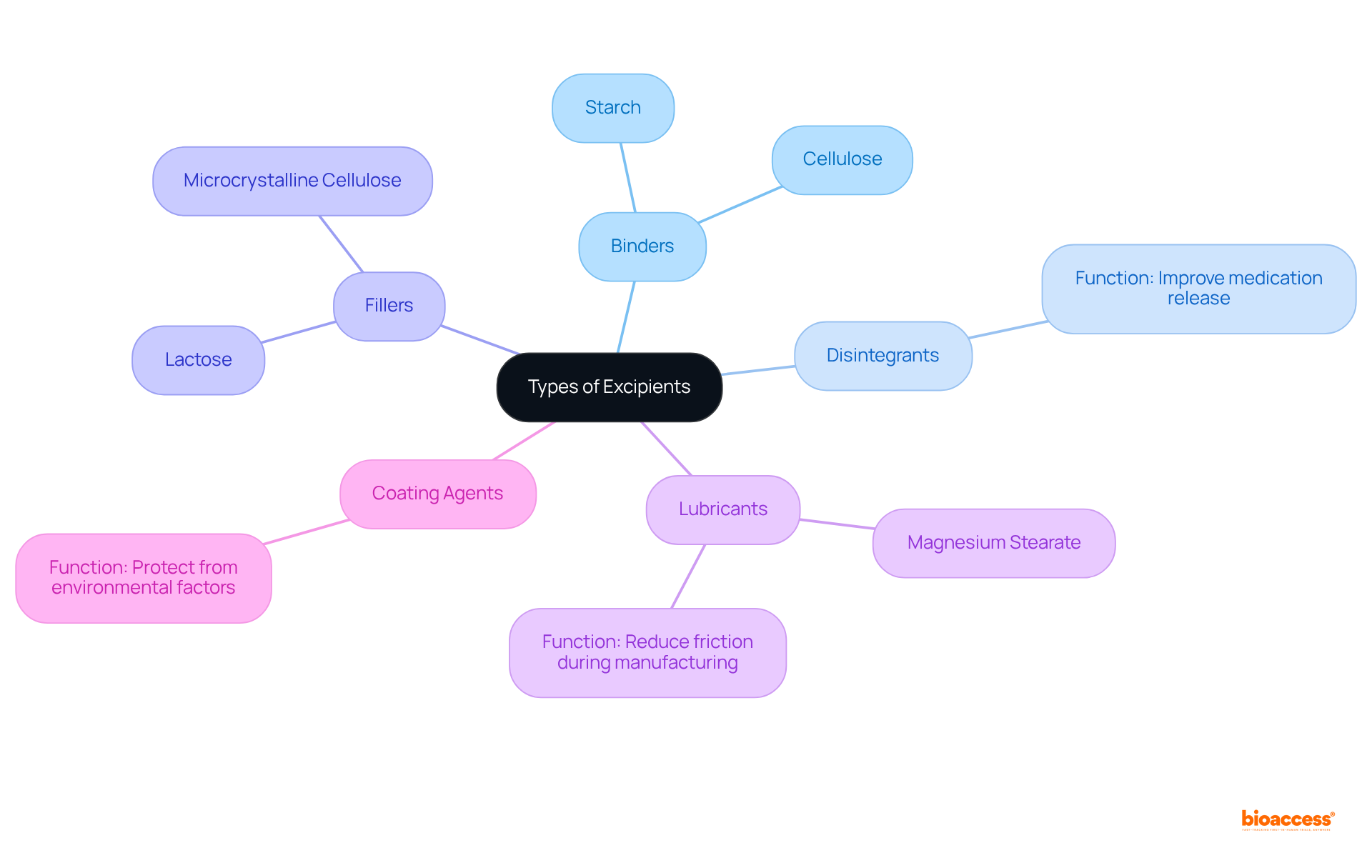


The term excipient in pharmaceuticals denotes inactive substances that play a vital role in enhancing the stability, bioavailability, and manufacturability of medications. Excipients, which encompass:
are essential not only for facilitating the effective delivery of active pharmaceutical ingredients but also for significantly influencing the overall efficacy and safety of drug formulations. Understanding the function and impact of excipients is crucial for professionals in the field, as their strategic use can lead to improved therapeutic outcomes.
Understanding the intricate world of pharmaceuticals reveals that the role of excipients—substances accompanying active pharmaceutical ingredients—extends far beyond mere fillers. These inactive ingredients are pivotal in ensuring the stability, bioavailability, and overall effectiveness of medications, with approximately 70% of marketed drugs relying on them.
As the pharmaceutical landscape evolves, a critical question emerges: how do these seemingly simple components influence drug formulation and patient outcomes? This exploration into the meaning of excipients uncovers their historical significance, diverse types, and critical importance in modern medicine, challenging the perception of excipients as mere additives in the quest for effective drug delivery.
The meaning of excipient refers to a substance included in a formulation alongside the active pharmaceutical ingredient (API). Unlike APIs, which provide therapeutic benefits, inactive ingredients serve critical functional purposes that enhance the formulation's stability, bioavailability, and manufacturability. They encompass a diverse array of substances, from inert fillers such as lactose to sophisticated compounds designed to improve medication delivery systems. Notably, approximately 70% of promoted medications incorporate inactive ingredients, underscoring their essential role in the pharmaceutical sector.
The meaning of excipient highlights its significance, as inactive ingredients extend beyond mere preparation and are vital in ensuring that medications are effective, safe, and reliable for patient use. Their impact on medication stability and bioavailability is profound, as they help maintain the integrity of the formulation and facilitate optimal absorption within the body. As the pharmaceutical industry evolves, the demand for innovative additives continues to rise, driven by the need for advanced drug delivery systems and personalized treatment options.

The application of additives has a rich history in ancient medicine, where natural substances such as honey and plant extracts were employed to enhance the delivery of active components. As the centuries progressed, the pharmaceutical sector evolved, leading to the development of more sophisticated substances. The 20th century marked a pivotal moment with the introduction of artificial additives, which allowed for improved control over medication composition, stability, and release profiles. In contemporary practice, understanding the meaning of excipient reveals that they are recognized as more than mere fillers; they are meticulously chosen components that can profoundly impact the pharmacokinetics and pharmacodynamics of drugs.

The meaning of excipient refers to essential components in pharmaceutical formulations, which are classified into several categories based on their functions.
Each type of excipient contributes significantly to the meaning of excipient in ensuring the stability, efficacy, and patient acceptability of pharmaceutical products. Recent studies underscore the significance of selecting suitable additives to preserve the integrity and effectiveness of medication compositions. For instance, the use of pre-gelatinized starch has demonstrated a 1.24-fold increase in swelling compared to standard starch and a 3.95-fold increase compared to unmodified starch, showcasing the potential of additives to improve formulation outcomes. Furthermore, the meaning of excipient is that it can modify the release rate of active ingredients, which is particularly important for chronic disease scenarios. They also play a crucial role in enhancing medication stability by protecting active ingredients from degradation. As the drug industry evolves, it is essential for formulators to stay informed about the latest advancements in excipient technology to create innovative, high-performance products.

Understanding the meaning of excipient is essential, as they play a crucial role in the formulation of effective and safe pharmaceutical products. Their influence extends to the stability of active components, enhancement of solubility, and improvement of bioavailability. For instance, the choice of excipient can significantly impact the rate at which a medication is released within the body, a factor that is vital for achieving the desired therapeutic effect. Furthermore, these additives can enhance patient adherence by improving flavor, appearance, and the ease of medication administration. As the pharmaceutical industry continues to evolve, the meaning of excipient is anticipated to grow, propelling advancements in drug delivery systems and personalized medicine.

The exploration of excipients underscores their indispensable role in the pharmaceutical industry, acting as crucial components that enhance the effectiveness and reliability of medications. Understanding the meaning of excipient reveals that these inactive ingredients are not mere fillers; they are vital for ensuring drug stability, bioavailability, and patient compliance.
Historically, the evolution of excipients is traced from ancient natural substances to modern synthetic additives, highlighting their increasing sophistication and importance in drug formulation. Insights into the various types of excipients—such as binders, disintegrants, fillers, lubricants, and coating agents—demonstrate how each uniquely contributes to the overall performance of pharmaceutical products. This knowledge reinforces the necessity for formulators to remain updated on advancements in excipient technology to optimize medication efficacy.
The significance of excipients extends beyond formulation; they are integral to the future of personalized medicine and advanced drug delivery systems. As the pharmaceutical landscape continues to evolve, a deeper understanding of excipients will empower stakeholders to create innovative solutions that enhance patient care and therapeutic outcomes. Embracing this knowledge can lead to breakthroughs in drug formulation, ultimately improving the health and well-being of patients worldwide.
What is an excipient in pharmaceuticals?
An excipient is a substance included in a pharmaceutical formulation alongside the active pharmaceutical ingredient (API). Unlike APIs, which provide therapeutic benefits, excipients serve critical functional purposes that enhance the formulation's stability, bioavailability, and manufacturability.
What roles do excipients play in medication formulations?
Excipients play several roles, including improving the stability of medications, enhancing bioavailability (the extent and rate at which the active ingredient is absorbed), and facilitating manufacturability. They are essential for ensuring that medications are effective, safe, and reliable for patient use.
What types of substances can be classified as excipients?
Excipients can include a diverse array of substances, ranging from inert fillers like lactose to more sophisticated compounds designed to improve medication delivery systems.
How prevalent are excipients in promoted medications?
Approximately 70% of promoted medications incorporate inactive ingredients (excipients), highlighting their essential role in the pharmaceutical sector.
Why is the demand for innovative excipients increasing in the pharmaceutical industry?
The demand for innovative excipients is rising due to the need for advanced drug delivery systems and personalized treatment options as the pharmaceutical industry evolves.